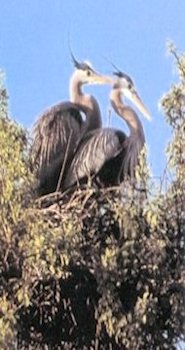
|
Avian Ecology
Basics of Avian Home Life The concept underlying the study of bird homes is that, like people, birds do more than live in their homes -- they interact with them. The home provides the resources of everyday survival; the use of resources influence the home. People decorate their houses, mow their lawns, plant trees, and pollute the environment with accumulations of waste. Similarly, birds adorn their nests with found items, disperse seed from the fruit they eat, and also pollute, such as excrement of nesting herons or roosting blackbirds kill the vegetation below them. Rocks and soil from the foundation of the avian environment, and North America provides an array of home sites -- from rugged coasts to gently rising plains; from steep mountains to stark, dry deserts. Great Blue Herons exchange duties at a tree-top nest. These colonial nesting birds prefer the seclusion of remote islands or inaccessible swamps as nesting sites. By placing their nest high, herons avoid ground-dwelling predators and enjoy an unobstructed view of their feeding habitat. |
Click Below for Bird Ecology Choices
|